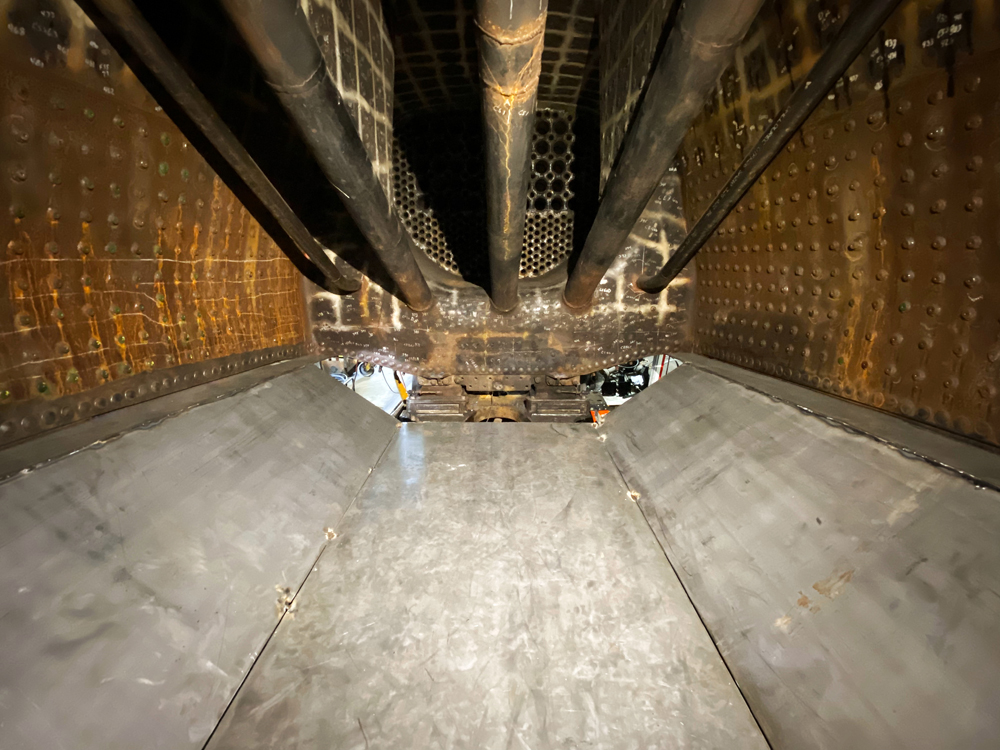
CLEVELAND — Construction of the oil firing system is the latest step in restoration work of Reading Co. T1 4-8-4 No. 2100, the American Steam Railroad Preservation Association reports.
“With the funding received this spring, work is well underway in regard to the construction of the oil pan,” Forrest Nace, the non-profit organization’s treasurer and restoration crew volunteer, said in a press release. “The design of the burner to take full advantage of the Wootten firebox is underway, with the front end blast pipe and petticoat changes soon to follow to ensure proper drafting.
“While funding given throughout the spring has made this oil conversion work possible, we still need to have funds coming in each month for all of the projects our volunteers must continue to do so as to keep our completion goal of 12 to 15 months from now on schedule, and to raise the remaining $145,000 needed for the restoration. The painting our volunteers are doing of the boiler and backhead have a cost of $180 per gallon for the heat resistant primer and $145 [er gallon for the heat resistant paint. The combined total of $325 only covers about 10 square feet when you apply two coats of each which comes to about $3,675 for this paint work. In addition to this, the wire wheels used for cleaning, paint brushes, rollers, and other consumable supplies and protective equipment add another $100-$200 per week to the costs. We are counting on donations, new memberships, and the sale of items from our on-line gift store each month to ensure our eight to 20 volunteers have the items and supplies they need to continue their vital work.” The association averages 11.7 volunteers for each Saturday work session.
Tax-deductible donations towards the restoration of the T1, which will wear American Freedom Train No. 250 livery, can be mailed to American Steam Railroad Preservation Association, 2800 W. 3rd St, Cleveland, OH 44113, or online at www.americansteamrailroad.org/donate/. Merchandise and a special members club is available here.














I’ll see if my friends would throw in some mercaptan, so it doesn’t smell like McDonald’s fries.
Is availability the issue? Fuel oil can be delivered by truck from a local supplier anywhere track is close to a road. No need to arrange for delivery of coal or inclusion of coal cars in a passenger consist. No need for a crane or front end loader to move it from a gondola to the tender. No need to handle ashes and dispose of them. No fire risk from hot cinders.
If the locomotive stays on a heritage railway and returns to a servicing area daily then coal is feasible. If the locomotive runs on mainline railways then fuel oil is much simpler.
Blasphemy. (Don’t get me wrong. I completely understand the reasons and utility for the conversion away from coal. Nevertheless, blasphemy.)
Do you…they’re based in the east, it’s far easier to get steam coal there than in some places in the west, seems like an unnecessary expense to me.
Well steam coal has to be bought in minimum lots before it is mined. Costs and availability are getting to be quite challenging as government continues its war on coal. Ash disposal is getting expensive, classified as a hazardous substance. As mentioned, operations on a set route can get the logistics together, but if touring, the logistics become extremely difficult and expensive.
From a purely logistical perspective oil greatly simplifies operations. Nevertheless, I love the smell of coal smoke in the morning…smells like victory.